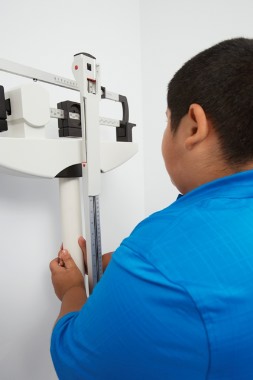User login
VANCOUVER, B.C. – Very few overweight and obese children outgrow their at-risk weight, and the window to address the problem is fairly narrow.
Dr. Raquel G. Hernandez, assistant professor of pediatrics at Johns Hopkins University, and her colleagues looked at obesity resilience, seeking to identify the prevalence of favorable growth patterns, such as healthy weight maintenance and return to healthy weight in school-aged children.
"There are pervasive expectations among parents that their children will magically outgrow their weight risk, and unfortunately, I think this applies to some providers as well," Dr. Hernandez said at the annual meeting of the Pediatric Academic Societies.
The researchers analyzed data on more than 9,000 children in the Early Childhood Longitudinal Study database, looking at their growth during the elementary school years. Measurements included body mass index (BMI), race/ethnicity, gender, and socioeconomic status and were compared for kindergarten, first, third, and fifth grade.
At baseline, nearly 26% of children were overweight or obese, while most (70%) were classified as healthy weight (BMI from the fifth through the 85th percentile). The rest were underweight. The majority of the cohort maintained healthy weight, but less than one in five (17%) of the overweight or obese children were able to return to healthy weight (BMI between the 5th and 85th percentile) over the study period.
In this unpublished study, Hispanic boys and girls were less likely to return to healthy weight, compared with children of other races/ethnicities. Boys of all races/ethnicities and socioeconomic statuses were more likely to be persistently overweight or obese. For girls, middle and low socioeconomic status was associated with lower likelihood of returning to healthy body weight.
"Most surprisingly, in contrast to pervasive expectations, greatest incidence of outgrowth occurred in overweight kids during kindergarten to first grade," said Dr. Hernandez, who is also associate director of medical education at All Children’s Hospital Johns Hopkins Medicine in St. Petersburg, Fla.
Less than 5% of children returned to healthy weight after third grade, she said.
"It’s time to open [the conversation about weight], and also parents should be open about having that conversation, knowing that outgrowth doesn’t really happen as frequently as we thought it would," Dr. Hernandez said in an interview.
The study had several limitations, she said. A portion of children weren’t included in the analysis because of missing relevant data, leading to potential for selection bias. Also, the criteria for return to healthy weight and healthy weight maintenance might have led to exclusion of children who made favorable transitions, the authors said.
"Curbing the pediatric obesity epidemic will depend on exploring all growth trends in children, including the potential for obesity-resilient growth patterns," said Dr. Hernandez. Future work should seek ways to help "clinicians to more deliberately message healthy weight maintenance and explore how these patterns can be more robustly discussed among children who are at risk, especially Hispanic children and children who have low socioeconomic status," she added.
Dr. Hernandez reported no financial disclosures. The research was funded by an institutional grant from the All Children’s Hospital Johns Hopkins Foundation.
On Twitter @naseemmiller
VANCOUVER, B.C. – Very few overweight and obese children outgrow their at-risk weight, and the window to address the problem is fairly narrow.
Dr. Raquel G. Hernandez, assistant professor of pediatrics at Johns Hopkins University, and her colleagues looked at obesity resilience, seeking to identify the prevalence of favorable growth patterns, such as healthy weight maintenance and return to healthy weight in school-aged children.
"There are pervasive expectations among parents that their children will magically outgrow their weight risk, and unfortunately, I think this applies to some providers as well," Dr. Hernandez said at the annual meeting of the Pediatric Academic Societies.
The researchers analyzed data on more than 9,000 children in the Early Childhood Longitudinal Study database, looking at their growth during the elementary school years. Measurements included body mass index (BMI), race/ethnicity, gender, and socioeconomic status and were compared for kindergarten, first, third, and fifth grade.
At baseline, nearly 26% of children were overweight or obese, while most (70%) were classified as healthy weight (BMI from the fifth through the 85th percentile). The rest were underweight. The majority of the cohort maintained healthy weight, but less than one in five (17%) of the overweight or obese children were able to return to healthy weight (BMI between the 5th and 85th percentile) over the study period.
In this unpublished study, Hispanic boys and girls were less likely to return to healthy weight, compared with children of other races/ethnicities. Boys of all races/ethnicities and socioeconomic statuses were more likely to be persistently overweight or obese. For girls, middle and low socioeconomic status was associated with lower likelihood of returning to healthy body weight.
"Most surprisingly, in contrast to pervasive expectations, greatest incidence of outgrowth occurred in overweight kids during kindergarten to first grade," said Dr. Hernandez, who is also associate director of medical education at All Children’s Hospital Johns Hopkins Medicine in St. Petersburg, Fla.
Less than 5% of children returned to healthy weight after third grade, she said.
"It’s time to open [the conversation about weight], and also parents should be open about having that conversation, knowing that outgrowth doesn’t really happen as frequently as we thought it would," Dr. Hernandez said in an interview.
The study had several limitations, she said. A portion of children weren’t included in the analysis because of missing relevant data, leading to potential for selection bias. Also, the criteria for return to healthy weight and healthy weight maintenance might have led to exclusion of children who made favorable transitions, the authors said.
"Curbing the pediatric obesity epidemic will depend on exploring all growth trends in children, including the potential for obesity-resilient growth patterns," said Dr. Hernandez. Future work should seek ways to help "clinicians to more deliberately message healthy weight maintenance and explore how these patterns can be more robustly discussed among children who are at risk, especially Hispanic children and children who have low socioeconomic status," she added.
Dr. Hernandez reported no financial disclosures. The research was funded by an institutional grant from the All Children’s Hospital Johns Hopkins Foundation.
On Twitter @naseemmiller
VANCOUVER, B.C. – Very few overweight and obese children outgrow their at-risk weight, and the window to address the problem is fairly narrow.
Dr. Raquel G. Hernandez, assistant professor of pediatrics at Johns Hopkins University, and her colleagues looked at obesity resilience, seeking to identify the prevalence of favorable growth patterns, such as healthy weight maintenance and return to healthy weight in school-aged children.
"There are pervasive expectations among parents that their children will magically outgrow their weight risk, and unfortunately, I think this applies to some providers as well," Dr. Hernandez said at the annual meeting of the Pediatric Academic Societies.
The researchers analyzed data on more than 9,000 children in the Early Childhood Longitudinal Study database, looking at their growth during the elementary school years. Measurements included body mass index (BMI), race/ethnicity, gender, and socioeconomic status and were compared for kindergarten, first, third, and fifth grade.
At baseline, nearly 26% of children were overweight or obese, while most (70%) were classified as healthy weight (BMI from the fifth through the 85th percentile). The rest were underweight. The majority of the cohort maintained healthy weight, but less than one in five (17%) of the overweight or obese children were able to return to healthy weight (BMI between the 5th and 85th percentile) over the study period.
In this unpublished study, Hispanic boys and girls were less likely to return to healthy weight, compared with children of other races/ethnicities. Boys of all races/ethnicities and socioeconomic statuses were more likely to be persistently overweight or obese. For girls, middle and low socioeconomic status was associated with lower likelihood of returning to healthy body weight.
"Most surprisingly, in contrast to pervasive expectations, greatest incidence of outgrowth occurred in overweight kids during kindergarten to first grade," said Dr. Hernandez, who is also associate director of medical education at All Children’s Hospital Johns Hopkins Medicine in St. Petersburg, Fla.
Less than 5% of children returned to healthy weight after third grade, she said.
"It’s time to open [the conversation about weight], and also parents should be open about having that conversation, knowing that outgrowth doesn’t really happen as frequently as we thought it would," Dr. Hernandez said in an interview.
The study had several limitations, she said. A portion of children weren’t included in the analysis because of missing relevant data, leading to potential for selection bias. Also, the criteria for return to healthy weight and healthy weight maintenance might have led to exclusion of children who made favorable transitions, the authors said.
"Curbing the pediatric obesity epidemic will depend on exploring all growth trends in children, including the potential for obesity-resilient growth patterns," said Dr. Hernandez. Future work should seek ways to help "clinicians to more deliberately message healthy weight maintenance and explore how these patterns can be more robustly discussed among children who are at risk, especially Hispanic children and children who have low socioeconomic status," she added.
Dr. Hernandez reported no financial disclosures. The research was funded by an institutional grant from the All Children’s Hospital Johns Hopkins Foundation.
On Twitter @naseemmiller
AT THE PAS ANNUAL MEETING
Key clinical point: Intervene before the first grade to help overweight or obese children achieve a healthy weight.
Major finding: Only 17% of children outgrew their at-risk weight by fifth grade.
Data source: Longitudinal analysis of the Early Childhood Longitudinal Study database.
Disclosures: Dr. Hernandez reported no financial disclosures. The research was funded by an institutional grant from the All Children’s Hospital Johns Hopkins Foundation.

